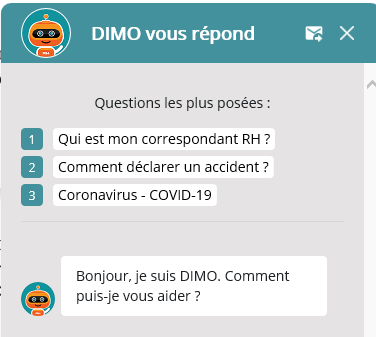The Conseil Départemental du Val d’Oise (local government council) implemented a HR chatbot in January 2020 to answer recurring questions from staff. The chatbot was created and deployed by Sword, an international consulting, software, and services company, in
partnership with dydu, an automated conversational software publisher.
The Conseil Départemental du Val d’Oise, Sword and dydu take a look back over the project, 6 months after the bot went live.
What issues were you trying to solve? Why did you choose a chatbot?
Karen Leclech, HRIS project manager at the Conseil Départemental du Val d’Oise
Nearly 4,000 people work for the Val D’Oise department, both on and off site. One of our main goals was to provide a tool that can be accessed 24/7, instantly answer the most frequent generic HR questions, and facilitate access to existing resources (particularly on the Intranet).
For example, in response to a recurring query about how to request leave days, the chatbot acts as an intermediary, providing both the answer and a link to the leave request form, available on the Intranet. Another equally important goal was to free up time for HR.
The chatbot handles generic questions, enabling our teams to focus on individual cases and provide more support. The chatbot therefore perfectly fits into our HR modernisation strategy. It is an innovative tool, and fully integrated with our Intranet. What particularly appealed to us was the training and support provided, the possibility to update the bot in line with any regulatory changes or new council projects, and its simple maintenance. For all these reasons, we launched a tender and chose dydu and Sword to bring our project to life.
What were the different stages of this project?
Samuel Payen, Digital Consulting Director at Sword
Sword is an IT solutions integrator and dydu partner. We supported and assisted the Conseil Départemental du Val d’Oise throughout this project. On average, it takes 8 to 12 weeks from start to finish to deploy a chatbot. This includes phases that are shared by all IT projects:
- launch: this is the framework of the project, when the scope, objectives and KPIs to be achieved and measured are defined.
- design and technical integration: the bot’s visual and editorial identity are defined so that it best embodies the Conseil Départemental du Val d’Oise. Any interconnections with internal software, such as the HRIS, are planned for at this stage. This is also when we talk about scalability with the different interfacing options, that will allow the tool to be updated later on. We work hard to support the HR and IT teams during this phase.
- training: the teams are trained to use dydu’s back-office so that they can build and update the chatbot’s knowledge base themselves and become completely autonomous.
- knowledge base: this is the chatbot’s content. A knowledge article includes a question and an answer. They are created by teams with expert knowledge on the subject, so in this case the HR department. We recommend creating approximately one hundred knowledge articles for a straightforward project, but nearly 500 were created for the Conseil Départemental du Val d’Oise. Sword created the first to help guide the teams before they then took over. The aim is for HR to be completely autonomous when it comes to their chatbot’s content. Behind the knowledge base is natural language processing, the added value brought by dydu’s software, which has been part of their solution for the past 10 years.
- testing: when the bot is almost ready for use, we carry out a testing phase before rolling it out to all users.
- follow-up and updates: this refers to the support, chatbot audits and any changes or updates made to the knowledge base, interconnections, functionalities, etc.
During the entire set up phase, a project manager was in close contact with the Conseil Départemental du Val d’Oise to provide weekly updates, monitor the risks and send an alert if any were to arise. He was assisted by a technical expert who configured the chatbot, set up any interconnections and liaised with the software IT teams. During the run phase, we provided technical assistance so that the Conseil Départemental could inform us of incidents or request any changes.
How did the project implementation go on the client-side?
Ophélie Lannoye, HR Support Officer at the Conseil Départemental du Val d’Oise
On our side, most of the work consisted in building the knowledge base. At first, we thought the chatbot would only address certain key themes, but we decided to extend the bot’s scope along the way to cover all HR topics. Which is why we have 500 knowledge articles instead of the recommended 100.
When building the base, we held several workshops internally to define the most frequent HR questions and their answers. In practice, we then tested the first knowledge articles on a Test group and on their departments. Through these workshops and tests, we finetuned the knowledge articles and defined the bot’s behaviour by customising its answers and identity.
During the test phase, we noticed that there were a lot of “personal” questions, such as “tell me a joke”, or “who are your parents”. But these questions don’t come up very often now that the chatbot is in place. We have however noticed a certain level of politeness in the way people address the bot, such as “Hello, thank you, goodbye”, “thank you for your answer”, etc. This shows that the project is successful and also reflects a certain respect for the tool and those working behind the scenes.

We also co-designed our chatbot Dimo internally, with the help of dydu and Sword. The avatar and chatbox colours were chosen by users within the Conseil Départemental, and we asked HR employees for their input too. This encouraged a better adoption of the tool.
What goals did you want to reach?
- Offer our staff a 24/7 service : our HR chatbot Dimo can be found on the Human Resources page of our Intranet. It is available at any time and provides instant answers.
- Strengthen our HR department’s innovative image : this HR bot has improved the image of our department, and I think other departments may be interested in doing the same.
- Provide generic and contextualised answers : we decided not to connect Dimo to our HRIS, so that users do not have to identify themselves. Our employees can chat with the bot anonymously and the answers are therefore generic and the same for everyone.
- Ensure users get an answer in 3 clicks max : we want users provide users with an immediate answer. If they don’t find what they’re looking for within 3 clicks (despite the bot rewording their request), Dimo offers to search the Intranet.
- Ensure HR managers can focus on high-priority issues : recurring questions tend to revolve around the same topics, such as leave, working hours and HR forms. By automatically replying to these questions, the chatbot frees up time for HR staff to handle more complex issues.
All these goals have been achieved or are close to being so. We are proud of our answer accuracy rate (90% to 95%). Our users are also satisfied and give their feedback directly via the bot through the answer rating system.
What are the next steps for this project?
We are continuing to communicate around the chatbot, to encourage user adoption. We are also continuing its deployment by making the best use of the tool’s features, such as the “top 3”, which highlights 3 hot topics in the chatbox.
As for the knowledge base, we will maintain the number of knowledge articles and adjust the answers according to current regulations and new projects. We are also studying other channels such as mobiles, and the addition of a voice functionality (voicebot).





